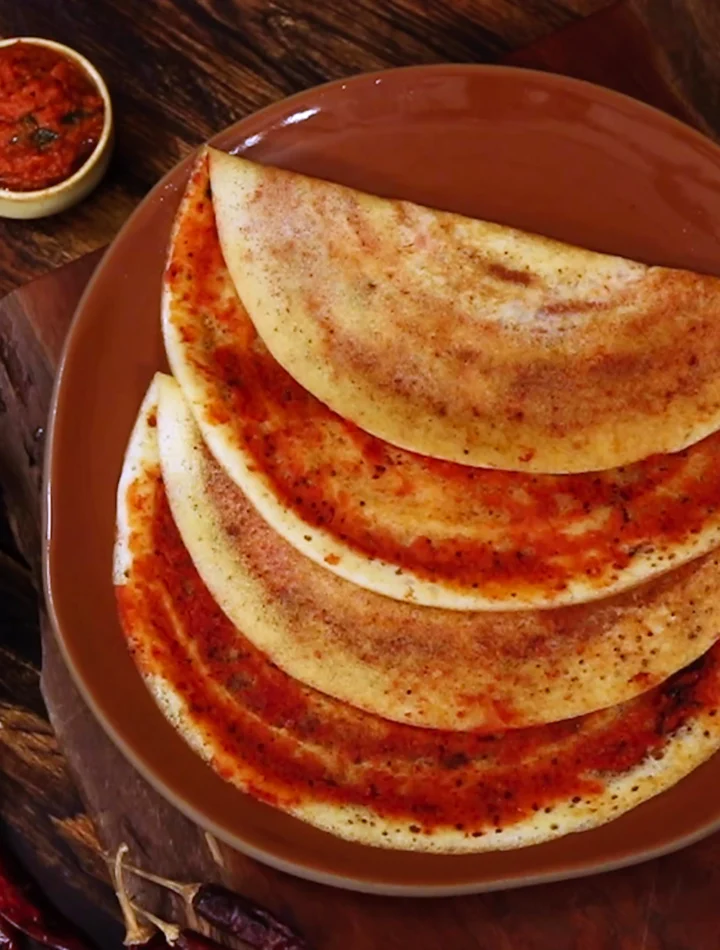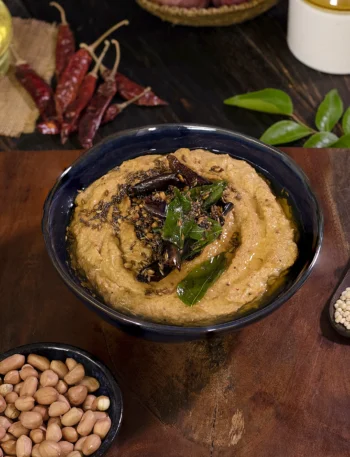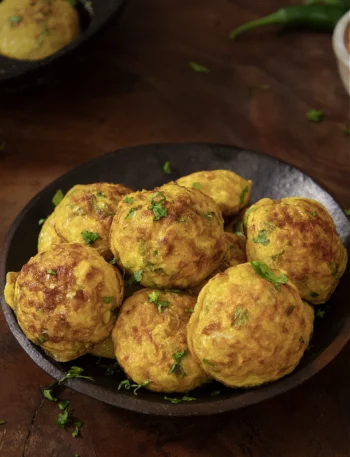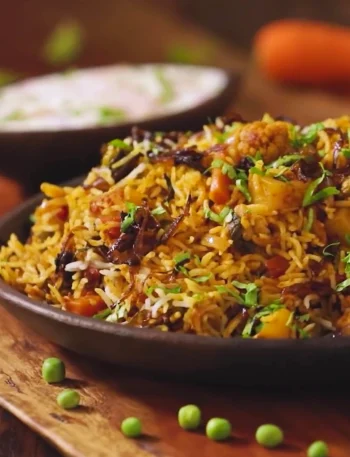Few dishes capture the essence of South Indian cuisine as perfectly as dosa. This golden, paper-thin crepe, with its delicate crispness and subtly tangy flavor, has been a breakfast staple for centuries. Whether you call it dosa, dosai, or dose, this dish is deeply woven into the everyday life of South India. In Tamil homes, it’s a staple breakfast, often served with sambar and coconut chutney. Meanwhile, Bangalore’s bustling streets are famous for their butter masala dosas, served with spicy chutneys.
Across India, dosa is a go-to meal for all occasions, from quick breakfasts to elaborate family dinners.
Today, dosa has transcended borders, becoming a global favorite. It’s not uncommon to find dosa being served in Indian restaurants from New York to London, loved for its crisp texture, versatility, and wholesome goodness.
Table of Contents
Why Fermented Batter is Great for Your Gut
The magic of dosa lies in its fermentation process. The rice and urad dal (black gram) batter is left to ferment overnight, allowing natural probiotics to develop.
Fermented foods have long been valued for their health benefits, and dosa batter is no exception! The natural fermentation process not only enhances the flavor but also makes it incredibly gut-friendly.
- Rich in Probiotics – The good bacteria produced during fermentation help maintain a healthy gut microbiome, aiding digestion and improving gut health.
- Easier to Digest – Fermentation breaks down complex carbohydrates, making dosa batter lighter on the stomach and easier to absorb.
- Boosts Nutrient Absorption – The process enhances the bioavailability of essential vitamins and minerals, especially B vitamins and iron.
- Regulates Acidity – The slightly acidic nature of fermented dosa batter can help balance stomach acids, reducing bloating and discomfort.
- Supports Immunity – A healthy gut contributes to a stronger immune system, and regular consumption of fermented foods like dosa can play a role in overall well-being.
This is why dosa isn’t just a delicious breakfast but also a wholesome, gut-friendly meal that’s good for digestion and overall health!
How to Make Dosa Batter – Step by Step
Soaking the Grains
Traditionally, dosa is made with idli rice and whole urad dal soaked separately for at least 4-6 hours.
Fenugreek seeds are often added to enhance fermentation and give a smooth texture.
Grinding to Perfection
The grains are ground using a wet grinder or high-powered blender, first grinding the urad dal to a fluffy consistency, followed by the rice into a smooth paste.
The two pastes are combined and mixed well.
Fermentation – The Heart of a Perfect Dosa
The batter is left to ferment in a warm place for 8-12 hours.
A perfectly fermented batter will double in volume, have a light sour aroma, and show tiny bubbles on the surface.
When to Add Salt?
In warm weather, add salt after fermentation to prevent over-fermentation.
In colder regions, adding salt before fermentation helps speed up the process.
How to Store Dosa Batter
Proper storage of dosa batter ensures it stays fresh, ferments well, and lasts longer. Here’s how you can store it the right way
1. Use Multiple Small Containers
Instead of storing the entire batch in one large container, divide it into smaller portions. This helps in two ways:
You only take out what you need, avoiding repeated exposure to warm temperatures (especially in hot climates).
It prevents contamination from frequent use of the dosa ladle.
2. Refrigeration
Once the batter has fermented (typically overnight or 8–12 hours, depending on climate), immediately transfer it to the fridge. This slows down further fermentation and keeps the batter fresh for up to 5–7 days.
3. Avoid Metal Containers
Always store dosa batter in a glass or food-grade plastic container. Metal containers can react with the fermented batter, altering the taste
4. How to Use Cold Batter?
Cold batter straight from the fridge may not spread well on the dosa pan. Let it sit at room temperature for 15–20 minutes before making dosas for better consistency.
How to Use the Batter?
- Day 1 (Fluffier Batter) – The batter is light and well-aerated, perfect for making soft, pillowy idlis.
- Day 2–3 (Balanced Fermentation) – The batter is ideal for crispy dosas with a slight tangy taste.
- Day 4–5 (More Sour & Fermented) – Best for uthappams or kuzhi paniyaram, where the slight sourness enhances the flavor.
Seasoning Your Dosa Pan – A Crucial Step for Perfect Dosas
A well-seasoned dosa pan (tawa) is key to making thin, crisp dosas that don’t stick. Whether you’re using a cast iron or iron tawa, proper seasoning ensures an even surface and enhances flavor over time.
How to Season a New Cast Iron/Iron Dosa Pan
If you’ve just bought a new cast iron or iron tawa, you’ll need to season it properly before making dosas:
- Initial Cleaning – Wash the pan with mild soap and warm water to remove any factory coatings. Dry it completely.
- Oil Coating – Apply a thin layer of any neutral oil (sesame or gingelly oil works best).
- Heating Process – Heat the pan on low flame for 10–15 minutes, then let it cool.
- Onion Rub Technique – Cut an onion in half and rub it across the surface while the pan is still warm. The onion’s natural starch creates a protective layer.
- Repeat 3–4 Times – For best results, repeat the oiling, heating, and onion-rubbing process at least 3–4 times before the first use.
How to Maintain a Seasoned Dosa Pan
Before making dosas each time, follow these steps to maintain a smooth, non-stick surface
- Preheat the Pan – Let it warm up on medium heat before pouring the batter.
- Light Oil Coating – Wipe the surface with a few drops of oil using a kitchen tissue or cloth.
- Onion Trick – Rubbing a cut onion on the hot pan helps create a temporary non-stick effect, preventing the first dosa from sticking.
What to Do If Your Dosa Pan Is Overheated?
If the tawa becomes too hot, the batter won’t spread evenly and may stick. Here’s how to fix it
- Sprinkle some water on the surface. If it sizzles immediately, the pan is too hot—let it cool slightly.
- Wipe the pan with a damp cloth to bring the temperature down quickly.
Best Type of Pan for Making Dosas
For restaurant-style crisp dosas, cast iron or iron tawas are the best choices. They:
- Retain heat well, ensuring even cooking.
- Enhance flavor over time as they get seasoned naturally.
- Are durable and long-lasting compared to non-stick pans.
Non-stick pans are beginner-friendly but may not give the same texture as traditional dosa pans. If using one, ensure it’s of good quality and avoid high heat, as this can damage the coating.
Exploring the Many Varieties of Dosa
Dosa is one of the most beloved South Indian dishes, enjoyed in countless variations across regions and cultures. From the classic crispy plain dosa to soft and spongy set dosa, from nutritious millet dosas to fusion-style cheese and masala dosas, there’s a version for every taste and dietary preference.
While traditional dosa batter is fermented for its signature tangy flavor and gut-friendly benefits, instant variations offer quick alternatives without fermentation. Whether it’s a staple breakfast in Tamil homes, a street food favorite in Bangalore, or a globally loved dish, dosa continues to evolve while staying true to its roots.
Soft & Fluffy Dosa Varieties
If you love thick, spongy dosas that soak up chutneys and sambar beautifully, then Set Dosa and Soft Bun Dosa are must-tries! Unlike the thin, crispy variety, these dosas are fermented to create an airy, pillowy texture, making them incredibly soft and flavorful. Their slightly sweet, tangy taste pairs wonderfully with spicy chutneys, potato masala, or even a simple drizzle of ghee. Perfect for breakfast or a light dinner, these fluffy dosas are a comforting South Indian favorite!
Set Dosa
Set Dosa is a thick, spongy variation of the classic dosa, known for its soft texture and slight tanginess. A staple in Karnataka, it’s made with a well-fermented batter that gives it an airy, melt-in-the-mouth feel. Unlike crispy dosas, set dosa is served in small, fluffy stacks, perfect for soaking up chutneys, sambar, or a flavorful kurma. Its fermentation process not only enhances taste but also makes it gut-friendly. Simple, comforting, and delicious—set dosa is a must-try for any dosa lover!
How to Make Set Dosa
Bun Dosa
Soft Bun Dosa is a thick, airy, and spongy dosa that melts in your mouth. Thanks to its well-fermented batter, it turns out incredibly soft with a slight bounce, making it perfect for soaking up chutneys and sambar. Unlike the usual crispy dosas, this version is light, mildly sweet, and packed with flavor. Serve it hot with a dollop of butter or your favorite chutney for a comforting and delicious meal!
How to make Bun Dosa
Dosa with Toppings – A Flavorful Twist
Dosa isn’t just about the classic plain version—it gets even better with delicious toppings! From crispy onion dosa to spicy podi dosa, cheesy fusion varieties, and veggie-loaded options, the possibilities are endless. Toppings not only enhance flavor but also add texture, making each bite exciting. Whether you love the crunch of finely chopped onions, the heat of gunpowder (podi), or the richness of melted cheese, there’s a version for everyone. These dosas are perfect for a hearty breakfast or a quick snack, served with chutneys and sambar!
Ghee Karam Dosa
A crispy, golden dosa infused with the rich aroma of ghee and the spicy kick of karam (red chili chutney). This street-style favorite from South India is simple yet packed with flavor, making it a must-try for dosa lovers!
How toMake Ghee Karam Dosa
Egg Dosa
Egg dosa is a delicious and nutritious variation of the traditional South Indian dosa. It combines the crispness of a dosa with the rich, fluffy texture of eggs, making it a wholesome meal perfect for breakfast, lunch, or even a light dinner.
How to Make Egg Dosa
Healthy Dosa Variations
Dosa isn’t just about indulgence—it can be a wholesome, nutrient-packed meal too! From fiber-rich ragi dosa to protein-loaded multigrain dosa, these variations are perfect for those looking for healthier alternatives without compromising on taste. Made with whole grains, millets, and lentils, they provide sustained energy, are gut-friendly, and keep you fuller for longer.
Explore these nutritious dosa recipes, each offering a unique flavor and health benefit, while still delivering the crispy, golden perfection dosa lovers crave!
Multigrain Dosa
Multigrain dosa is a wholesome and nutritious take on the traditional dosa, made by combining a variety of grains and lentils. Packed with fiber, protein, and essential nutrients, this dosa is perfect for a healthy start to your day. The mix of grains adds a unique depth of flavor and a slightly crisp yet soft texture, making it both delicious and filling. Whether you’re looking for a high-energy breakfast or a light dinner, this dosa is a great way to enjoy a balanced meal while keeping it tasty!





